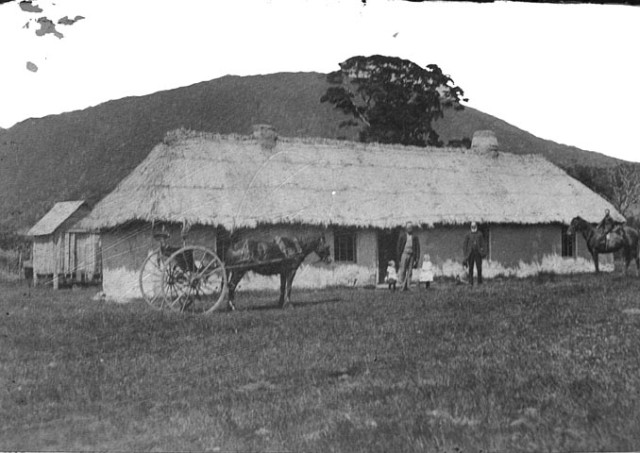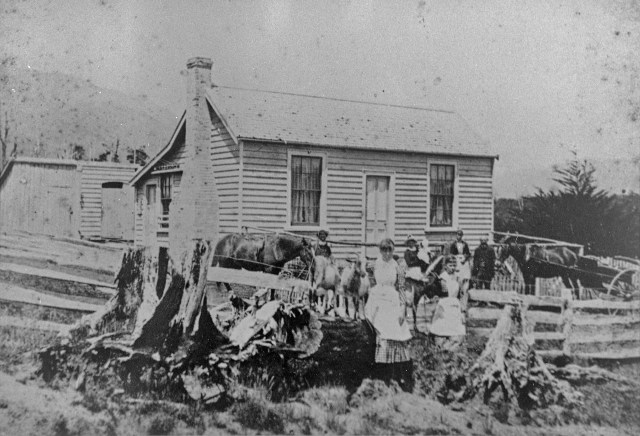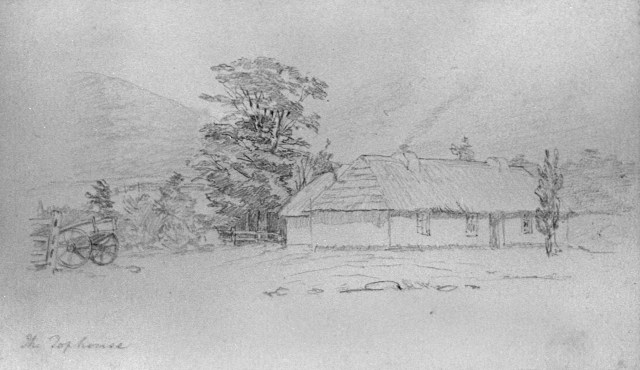Tophouse
Tophouse, the scene of a murder/suicide in 1894, was the natural pass between the Wairau, Motupiko and Buller Rivers, and was commonly used by Maori in pre-European times. Tophouse Pass became a vital route to the east, west and south for European settler
Tophouse, the scene of a murder/suicide in 1894, was the natural pass between the Wairau, Motupiko and Buller Rivers, and was commonly used by Māori in pre-European times. Tophouse Pass became a vital route to the east, west and south for European settlers in the second half of the 19th Century.
Murder/suicide at Tophouse
Located on the old boundary between Marlborough and Nelson, the isolated Tophouse Pass has seen a surprising amount of action over the centuries.
Bill Bateman, brother-in-law of the Tophouse Hotel’s owner, became jealous of John Lane’s attentions to the local schoolteacher, Miss Wylie. In October 1894, while hotel owner Nathaniel Longney and his wife were away, Bateman shot Lane in the back of the head. He then went to the nearby telegraph station and killed the linesman, William Wallis.
Bateman tried to persuade Miss Wylie to go for a walk with him, but she became suspicious and went to the telegraph station, where she remained with Mrs Wallis and the children. When the Nelson police arrived the next day they found Bateman had shot himself.1
The Tophouse Pass has been an important route since pre-European times, being used by Māori to access the rest of the South Island and as an escape route. From colonial times, following its discovery in 1842/43 by New Zealand Company surveyor, John Cotterell (later killed at the Wairau) and a party of explorers, it became the main route to the Wairau Valley and Lake Rotoiti. In 1843, frightened and starving, John Kidson and four others, escaping after the Wairau Affray, returned to Nelson via the Tophouse Pass. 2
Nathaniel Morse and Dr. John Cooper drove the first flock of sheep through to the upper Wairau Valley from the Motueka area in November 1846. The land issue had not been settled and they were essentially squatters. Their homestead was on a terrace above the Wairau River and the station was named Top House, as it was higher and further inland than any other.3
By 1856, the homestead was an accommodation house and it was a welcome stop on the journey from Nelson to the Wairau or North Canterbury. In 1859 Adolph Wiesenhavern (pictured in Telegraph House photo; man on extreme left) had a hotel built on the south side of the road down the Wairau Valley and he presided at this Top House Hotel until 1882, with a meal and chaff for the horse being two shillings each.4
In 1876 the Tophouse telegraph station was established to the north of the Wairau road, about three miles from Wiesenharvern’s hotel. It became a major telecommunications link, having circuits to the Wairau and the Buller, and the building still stands.5
On November 19, 1886 the Colonist published a damning report about the condition of the Top House hotel, now occupied by Nathaniel Longney, after an inspection by the Nelson Land Board. It was recommended the lease be cancelled unless improvements were made.
In 1887/1888 Longney bought land near the telegraph station and built the present Tophouse Hotel. He commissioned master cob house builder, Ned James, to erect the hotel. People danced all night at a mid-winter party celebrating the opening of the hotel, and next morning found themselves snowed in with two miles of telegraph line down.
A Post Office opened at the Tophouse telegraph station in 1891, when the name was standardised as one word, and closed in 1931.6
Nathaniel Longney sold the hotel soon after the murder/suicide tragedy. In 1899 it was bought by the Tomlinson family, who ran a good business for more than 20 years. After the death of his father, Arthur, in 1910, 18 year-old Jack Tomlinson became responsible for getting rid of brawling drunks. One man, who was sent on his way with a bottle of gin, was found dead en route to the Rainbow.7
One-time Labour Prime Minister, Bill Rowling, boarded at Tophouse Hotel as a young teacher at St Arnaud school. 8
In the 21st century, guests are again welcomed to the 1880s mud cob hotel, where they can search for bullet holes in the verandah roof. 9
December 2008 (updated December 2020)
Read the following stories about the Tophouse murder:
- The Tophouse tragedy by Sophie Beaumont, Nelson College for Girls, 2009.
- Love, Jealousy, Murder and Betrayal. The Top House Tragedy by Laura Wilkinson, Nayland College, 2011
Story by: Joy Stephens
Sources
- Rotoiti recollections: a collection of memoirs, historical writings and personality profiles relating to Lake Rotoiti, Nelson Province. (1992) Nelson, N.Z.: St Arnaud Community Association, p 64;
- Newport, J N W. (1962). Footprints: the story of the settlement and development of the Nelson back country districts. [N.Z.]: Whitcombe & Tombs, p 53-54
- Newport, pp. 30-32
- Newport, p. 34
- Newport, p. 37
- Newport, pp. 45-46
- Newport, p. 41
- Newport, p. 50
- Rotoiti recollections, p 65
- Rotoiti recollections, p 115.
- Tophouse Historic Inn: http://www.tophouse.co.nz/
Further Sources
Books
- Harris, Jill. (2002). A place to live: the Tasman District, a community profile. Nelson, N.Z.: Dry Crust. p. 61
http://www.worldcat.org/oclc/156392246 - Newport, J N W. (1962). Footprints: the story of the settlement and development of the Nelson back country districts. [Christchurch, N.Z.]: Whitcombe & Tombs.
http://www.worldcat.org/oclc/18091608 - Rotoiti recollections: a collection of memoirs, historical writings and personality profiles relating to Lake Rotoiti, Nelson Province. (1992) Nelson, N.Z.: St Arnaud Community Association.
http://www.worldcat.org/oclc/154761744 - Tomlinson, J.E. (1968). Remembered trails. Nelson, N.Z.: J.E. Tomlinson.
http://www.worldcat.org/oclc/152399439
Newspapers
Articles
[Where no hyperlink is supplied ask at your local library about full text access to the articles.]
- Blechynden, J. N.(1995). John N Blechynden of the Roundell. Journal of the Nelson and Marlborough Historical Societies, 2(6), 37-43.
http://www.nzetc.org/tm/scholarly/tei-NHSJ05_06-t1-body1-d10.html - Godbaz, Graeme (2005, Feb/Mar). Nelson Lakes. New Zealand Memories, 52, p.66-67
- Kelly, Clare. (2008, Spring). Elemental, not egalitarian: accommodation houses of 19th century. Heritage New Zealand. 110, 26-29.
- Murder and suicide a shocking affair.(1894, October 6) Grey River Argus, p. 2
https://paperspast.natlib.govt.nz/newspapers/GRA18941006.2.7 - Murdoch, Helen. (2008, February 1) Hotel can again sell alcohol .The Press, pA6
- Murdoch, Helen (2010, February 17) Homicide with your hospitality. The Dominion Post. Travel, 17
- Neal, Tracy.(2008, January 19) Couple breathe life into historic bar. Nelson Mail, p.3
- Newport, J.N.W & Dickinson, B. (1974). Wairau Valley field trip; others who made the trip down the Wairau Valley before us. Journal of the Nelson Historical Society, 3(1),11-19
http://www.nzetc.org/tm/scholarly/tei-NHSJ03_01-t1-body1-d2.html - Obituary: John Edward Tomlinson. (1988). Journal of the Nelson and Marlborough Historical Societies, 2 (2), 29
http://www.nzetc.org/tm/scholarly/tei-NHSJ05_02-t1-body1-d8.html - The Tophouse tragedy (1894, October 8) Colonist, p.2
http://paperspast.natlib.govt.nz/cgi-bin/paperspast?a=d&d=TC18941008.1.2 - The tragedy at Top House: double murder suicide. (1894, October 6) Nelson Evening Mail, p. 2
http://paperspast.natlib.govt.nz/cgi-bin/paperspast?a=d&d=NEM18941006.1.2 - Tomlinson, J E. (1983). Tophouse Hotel; The Tophouse Telegraph and Post Office. Journal of the Nelson and Marlborough Historical Societies, 1(3), 34-35
http://www.nzetc.org/tm/scholarly/tei-NHSJ04_03-t1-body1-d8.html - Tophouse tragedy: the inquests. (1894, October 8) Nelson Evening Mail, p. 2
http://paperspast.natlib.govt.nz/cgi-bin/paperspast?a=d&d=NEM18941008.1.2 - Tophouse to get facelift (2000, October 26) The Press, p.7
- Youngmeyer, D. (1997, January 14) Tophouse gets historic places trust go ahead. Nelson Mail.
Websites
- Tophouse (2008). Retrieved 30 October 2008, from Wikipedia: http://en.wikipedia.org/wiki/Tophouse
- Tophouse Inn: historic Tophouse guesthouse (n.d) Retrieved 4 August 2015, from:
http://www.tophouse.kiwi. - Tophouse Route - New Zealand" Waymark (n.d.). Retrieved 30 October, 2009 from:
http://www.waymarking.com/waymarks/WM17PK
Maps
Unpublished sources
Available at the Nelson Provincial Museum:
- Gregan, Barbara (1998). Jonathan: story of Jonathan Brough intrepid Nelson pioneer. qMS GRE
- Nelson Provincial Museum. N.D. Tophouse Hotel. HPT File
- Richmond, James Crowe. (1863). Diary. MS RIC
- Rigg, Theodore. (1950). John Sylvanus Cotterell. qMS RIG
- Available at the Marlborough Museum:
- Marlborough Historical Society. Tophouse research box.


